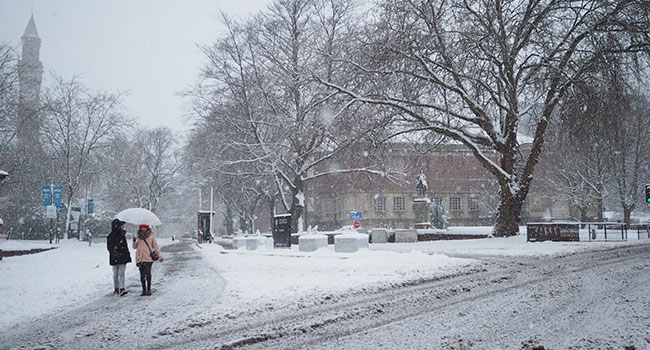
Turn Up the Heat
How to plan for outdoor cold to minimize safety concerns
- By Bob Lester
- April 01, 2021
With cold weather on the horizon,
the likelihood of accidents caused
by slick conditions will be increasing,
creating yet another safety
concern for schools to manage
during the pandemic. To minimize risk –
and the extra burden on staff– this winter,
school facility managers need to think ahead
and stay informed about the risks of seemingly
minor problems, including cracks and
holes in their parking lots.
Tackling these repairs reduces the risk of
handling injured students who have fallen or
been a part of a motor accident. Nurses,
teachers and students are already dealing
with enough stressors brought on by the
pandemic, they shouldn’t have to worry
about hazardous parking lots as well.
When preparing your campus lots for the
winter, consider these tips to reduce motor accidents,
increase the longevity of your lots and
walkways, and keep students and faculty safe.
Don’t Wait to Fill Cracks
While paving projects are more widely completed
during the spring and summer
months, emergency fixes during the winter
are a necessity. With winter comes cold
weather that can increase the chance of damage
to your lots and walkways. Filling cracks
in a parking lot as soon as they start developing
so they don’t expand will save you from a
large-scale replacement project, which can
go a long way during a time when schools are
trying to conserve budgets to account for
PPE and other pandemic-related expenses.
More importantly, assessing your parking
lots health now will protect students and faculty
from falls and damaged vehicles. Even
though November and December are considered
the off-season for many paving companies,
most, including Dura-Seal, will perform
crack-filling services in the winter when maintenance
just can’t wait for warmer weather.
Temporarily Fix Potholes During Winter
Pothole repairs should never be put offuntil
spring. Using gravel or stone to fill in potholes
can lead to safety hazards that further
damage your parking lots.
Additionally, gravel and stone patches can
expand, causing the pothole to grow and lead
to more expensive repairs down the road. A
temporary, yet effective, fix for potholes during
the winter is cold patching when hot
mixed asphalt is not available.Cold patching
can keep a parking lot and school driveways
healthy and smooth throughout the winter
before potholes become a permanent problem
that can be both costly and hazardous.
Mark Concrete Curbs and Potholes
Inclement weather like snow and sleet can
mask concrete curbs and potholes, leaving
parking to be a guessing game. Campuses
should purchase flags to mark their concrete
curbs so that snowplows don’t damage them
and drivers can avoid accidents.
When it comes to potholes, if permanent
repairs can’t be done until spring, mark them
with traffic cones and schedule an appointment
to have repairs professionally done
once it’s warmer.
Move Snow Downhill
With sub-zero temperatures and snow comes
the potential for ice. Keep snow piles on the
lower side of your parking lot whenever possible
so that when the snow melts, the water
runs into the grass and doesn’t cause refreeze
issues on the pavement, walkways, or driveways.
This will protect your students and faculty
from falls and reduce the likelihood of
car accidents caused by frozen lots.
Prioritizing these items is important now
more than ever. Staying ahead of seemingly
minor problems and making sure to be
informed on parking lot maintenance best
practices will allow for more energy to be put
into protecting students from pandemicrelated
safety issues, rather than large-scale
maintenance issues.
This article originally appeared in the March / April 2021 issue of Campus Security Today.
About the Author
Bob Lester is president and CEO of Columbus, Ohio-based Dura-Seal.